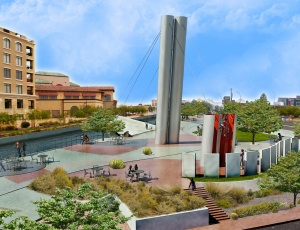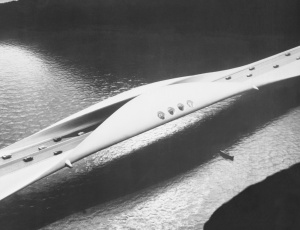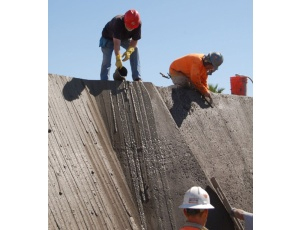


The hollow lower pylons have gaps in their cylindrical shape to reveal a 10-ft-high assembly of bronze windbells hanging within. Known as the Goldwater Bells, they were originally cast by Soleri in 1969 and were displayed at the Goldwater Department stores in Phoenix, says Roger Tomalty, who has worked with Soleri for 40 years with the Cosanti Foundation, Soleri’s nonprofit educational foundation.
The four pylons are clad in brushed stainless steel chosen by Soleri for its elegance and simplicity. The surfaces also have a special finish that reduces glare, Douglas says.
Radiused stainless-steel panels on the outer bridge edges wrap around and also serve as guide rails along the inner edge of the bridge. Tucson-based CAID Industries fabricated these wraparound panels to be lightweight and modular to provide for their installation by its mobile jog rather than with heavy mechanized equipment on the bridge, says Dennis L. Garrison, CAID’s senior vice president. The firm also provided the connecting brackets securing the stainless steel pylon skins.
Designers had to account for temperature expansion/contraction, suspension cable drape, water level and the shape of the stainless steel bridge panels, says Cliff Paul, PK Associates’ principal in charge and project manager.
Construction crews had their own set of challenges, including contending with active maintenance operations of the canal, major underground utilities and the heavy traffic on Scottsdale Road, Douglas says.
The project includes 11 pre-cast concrete panels, each functioning as a unique artwork. Ten of the 8-ft-high, 5-ft-wide panels are staggered along one edge of the south plaza and one double-sized panel is located on the north bank.
Using the earth-casting method developed to create the buildings at Cosanti, Soleri hand-carved the designs into earth forms, Tomalty says. Concrete was then poured into each of these forms, producing the uniquely cast final panels, which were then delivered to site. Soleri staff closely coordinated with the construction team, which prepared the foundations and hid the securing connections.
For soil retention at the south end of the sloped plaza, Tomalty completed “drip walls,” another technique innovated at Cosanti. He first carved the earth into what he calls “facets”: a series of differing planes both for strength and aesthetics, to reveal changing light patterns throughout the day. Then, reinforced concrete was cast against this surface. Immediately, the team poured concrete slurry, allowing gravity to create a drip texture.
“This is a once-in-a-lifetime project for many members of the team,” says Steve Boscardin, project manager with Howard S. Wright. “The Soleri Bridge is a signature piece of art being built by a construction team, incorporating the design intent and finishes of an artist’s vision which began 20-plus years ago.”


Post a comment to this article
Report Abusive Comment